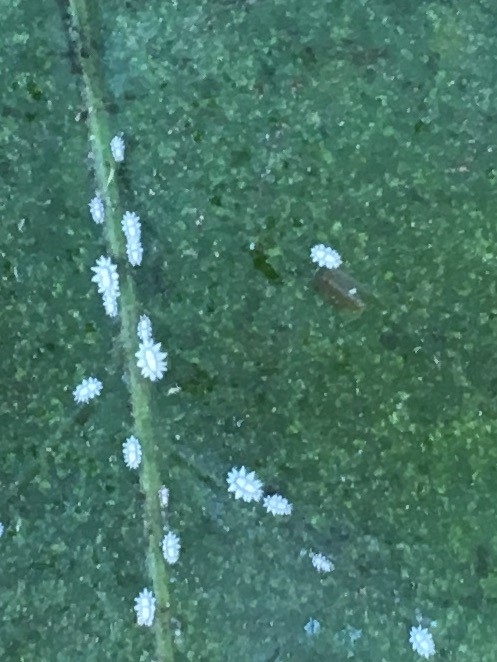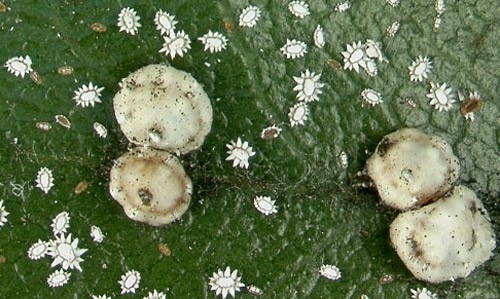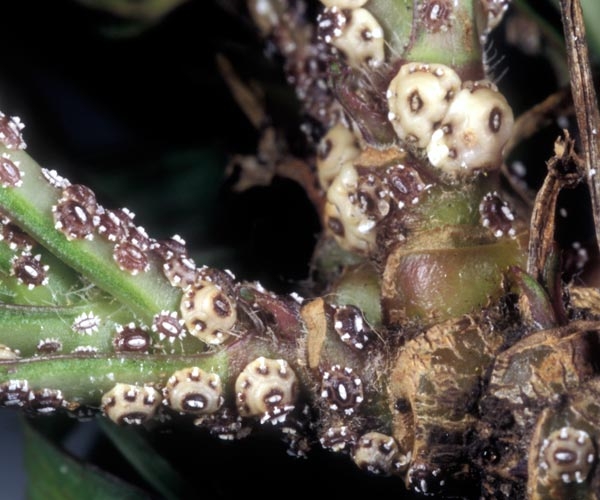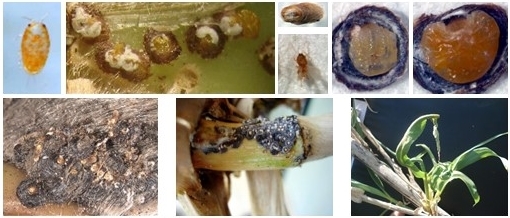
Posts Tagged: biological control
Invasive Scale?
Recently a grower called up with a beautiful scale that the PCA couldn't identify. I could just marvel at the beauty of it and wondered what in the heck it was. It didn't look like any scale I had seen in the area and others who were queried didn't know either.
I took it into the Ag Commissioner's office and they sent it off to see if it was a new species. Images were sent off to various entomologists and David Haviland in Bakersfield identified it as a Ceroplastes, possibly a Chinese wax scale or Barnacle scale. Others had identified it as Florida wax scale.
It was sent into Paul Rugman-Jones at UC Riverside Entomology for DNA identification. His identification and that of CA Dept of Food and Ag entolomogists came back as Barnacle scale, Ceroplastes cirripediformis.
All of these scales turned out to have been seen in California before, so there was no quarantine issue. It also turned out that all of the adults that were turned in for identification had also been parasitized by some wasp. So there is biological control already in place for it. The issue at stake here, though, is that it's important to be watching for new visitors in the orchard. Joe Morse now retired from UC Riverside Entomology lead a team that intercepted avocados coming into the US. They found a number of scale insects that were new to California and new to the identification world. A number of these scale are parthenogenic, meaning they can reproduce without males, and just one lone female could possible balloon into a massive population in a short time. And on a scale like that, trees would have a hard time without some serious intervention.
Would You Let Your Neighbor Buy THAT Product
providing some advantage to the farmer. Frequently, these are new fertilizer mixes presented as proprietary cocktails promoted and dispensed with promises of a multitude of profitable (yet improbable) benefits to the buyer. With the large number of new products available, and the number of salespeople promoting them, it is often difficult for growers to distinguish between products likely to provide real benefit, and those that may actually reduce the profitability of the farm.
In all situations when a company approaches the University or a commodity research board with a new product or technology for sale to California growers, these institutions act as grower advocates. They are charged with sorting through the available information; asking the right questions; getting the necessary research done if the available information warrants this pursuit; disseminating accurate information on these new technologies and products, and doing all that can help maximize grower profits now and in the future. When approached with a new product or technology it is obligatory to challenge claims with the following questions:
Is there some basic established and accepted scientific foundation on which the product claims are made?
Language that invokes some proprietary ingredients or mysterious formulations, particularly in fertilizers mixes registered in the State of California, raises red flags. A wide range of completely unrelated product benefit claims (such as water savings, pesticide savings, increased earlier yield) raises more red flags. Product claims that fall well outside of any accepted scientific convention generally mean the product is truly a miracle, or these claims are borderline false to entirely fraudulent.
Has the product undergone thorough scientific testing in orchards?
Frequently, products are promoted based on testimonials of other growers. While testimonials may be given in good faith, they are most often not backed up by any real scientific testing where a good control was used to compare orchard returns with and without the product.
A “test” where a whole block was treated with a product and which has no reliable untreated control does not meet accepted standards for conducting agricultural experiments. Also, a treated orchard cannot reliably be compared to a neighboring untreated orchard; and a treated orchard cannot be compared to the same orchard that was untreated the previous crop year. Even a test with half a block of treated trees and half untreated is not considered dependable by any known scientific standard of testing.
Only a well designed, statistically replicated, multi-year trial allows for direct comparison of untreated versus treated trees with statistical confidence. Verifiable data from tests that meet acceptable standards of scientific design, along with access to raw baseline (before treatment) yield data from the same trees (preferably for the two years prior) should be used to determine the validity of test results provided.
Are the test results from a reliable source?
If the testing were not done by a neutral party, such as university scientists, agency, or a reputable contract research company using standard scientific protocols, this raises red flags. If the persons overseeing the tests have a financial interest in seeing positive results from the product, it raises red flags.
Does the product have beneficial effects on several unrelated farm practices?
A product that increases production of trees, makes fruit bigger, reduces pests, reduces water use, and reduces fertilizer costs, is more than a little suspicious. In reality, if such a product really existed, it would not need any testing at all because its benefits would be so obviously realized by the grower community that it would spread rapidly by word of mouth and embraced by the entire grower community.
Are other standard and proven farm products put down in the new product sales delivery?
If a new product vendor claims that their product is taken up 15 times faster than the one growers are currently using, or is 30 times more efficient, it probably costs 15 to 30 times more per unit of active ingredient than the standard market price. Growers should always examine the chemical product label to see what active ingredient they are buying. There has to be a very good reason to pay more for an ingredient where previously there had been no problem supplying the same ingredient at a cheaper price to trees in the past.
There are impartial sources of such information available to farmers to help corroborate information provided by product vendors. Perhaps the most reliable and accessible impartial research and education resources for growers are their local Cooperative Extension Farm Advisors and commodity research boards.
When promising products emerge, local university Farm Advisors can advise growers on how to evaluate these products and may help design a small trial to test a particular product on a few trees under local orchard conditions. If in these pursuits a truly promising new product or technology emerges, research board funding may follow but only on the recommendation of that board's Research Committee.

unknown product
Biological Control of Giant Reed- Arundo
Editor: Guy B Kyser
The giant invasive grass arundo (Arundo donax), one of the weeds targeted under the USDA-ARS-funded Delta Region Areawide Aquatic Weed Project (DRAAWP), has been re-acquainted with one of its natural enemies imported from arundo's native range. A tiny insect called the arundo armored scale (Rhizaspidiotus donacis) has been successfully released in the Sacramento River watershed and in the Delta.
Arundo forms dense stands across at least 10,000 acres in California, and over 100,000 acres in other arid riparian areas such as the Lower Rio Grande Valley of Texas and Mexico. Other control methods such as herbicide application, mechanical removal, mowing or burning have been used to reduce arundo populations in California, costing tens of millions of dollars. However, arundo is a tough plant and takes advantage of human disturbance and fire in riparian habitats along creeks, sloughs, rivers and reservoirs. Arundo populations in California thus exceed the capacity of these other control methods. In the absence of control, arundo consumes and wastes scarce water – a single plant can consume as much water as corn when growing in moist soil under hot, sunny conditions. Dense arundo stands block access to water for irrigation and recreation, and also obstruct flood control structures such as drainage ditches. Arundo also displaces native plants and animals and alters geomorphology and water flow dynamics in riparian habitats in ways that make it difficult for the natives to come back even if the arundo is controlled.
Biological control of invasive weeds focuses on the characterization, release and evaluation of insects (or plant pathogens) from the weed's native range into areas where the weed is non-native. The arundo armored scale was collected originally in southern France, Spain, and Italy. Studies by Spanish collaborators showed that, even in its native range with its own natural enemies, the arundo armored scale reduces shoot growth and rhizome size by 50%.
Biological control agents undergo rigorous testing to ensure they are not a threat to native plants or crops. After a permit review process, the USDA granted a permit for field release of arundo armored scale in 2010. (This is one of two insects that have been released for biological control of arundo in North America.) Since 2011, this biological control agent has been released in the Lower Rio Grande Basin. Initial releases of this agent in California began in 2014, and it was found that the scale insect had become established at one site in the northern Sacramento Valley by November of that year.
Armored scales are small insects that spend most of their lives in an immobile state, covered by their waxy secretions (‘armor'). Adult females produce ‘crawlers' that disperse locally (typically just a few feet) to find new buds coming up from the arundo rhizomes or lateral shoot buds above ground. The crawlers then lose their legs and antennae and insert their stylet-like mouthparts into the arundo tissue to feed on the fluids in the plant's vascular system. Crawlers molt to a second immature phase, and about six to eight weeks later, short-lived adult males emerge from their armor and mate with the immobile adult females. The females continue to feed and slowly develop embryos. A new generation of crawlers then emerges from the females. The life cycle takes four to six months.
Top row, left to right: Tiny (0.5 mm) crawlers emerge from females and settle on rhizomes or lateral shoots. Second-instar immature scales continue to feed and expand. Winged adult males emerge from their oyster-like scale covering. Females (armored scale cover removed) are shriveled and skinny right after molting. Mature females are plump and turn a darker color when they are full of crawlers ready to emerge. Bottom row, left to right: Adult females form aggregations on arundo rhizomes and shoots. The presence of armored scale populations causes shoot distortion and reduces both shoot growth and rhizome size.
In 2015, we tested a new release technique using arundo ‘microplants'. We soaked arundo shoot fragments in water for one month, then planted them in pots where they produced new shoot buds and roots. Armored scale crawlers were released onto the microplants. After about six months, we planted the infested microplants at field sites in the Delta – Andrus Island on the Sacramento River, and at Big Break near Oakley – and along Stony Creek in Glenn and Butte Counties north of the Delta. We established the microplants adjacent to large arundo shoots, and we cut off some of the established shoots to encourage production of new rhizome buds and lateral shoots. We watered the microplants as needed to keep them alive for about 6 months.
Left to right: Microplant with gelatin capsules used to isolate scale crawlers from females (capsules had been opened and crawlers poured onto the base of the plant). Greenhouse bench with arundo microplants. Field plot with arundo shoots cut back to promote new shoot and rhizome growth. Base of an arundo shoot at the field site (arrow indicates location of adult female scales that developed from crawlers that had previously came out of the females on the microplants.
Almost one year after planting, in November 2016, we sampled arundo rhizomes and shoots from the areas where the now-dead microplants were placed. At the Sacramento River site, 150 females were found, and at a site on Stony Creek in Butte County, 72 females were found. The females were placed in gelatin capsules to capture crawlers. A total of 1,668 crawlers emerged by early January 2017. Since there are still many more arundo shoots around the microplant sites, these results indicate that the arundo armored scale has established reproductive populations at three sites in California. This is the first establishment of this biocontrol agent in the state. Additional releases are planned throughout the Delta and surrounding watersheds. Along with the arundo wasp (Tetramesa romana), the arundo armored scale is expected to significantly reduce the potential for arundo to grow, disperse and form damaging populations that threaten water resources.
This work is conducted under the USDA-ARS-funded Delta Region Areawide Aquatic Weed Project (DRAAWP). This portion of the project is led by Dr. Patrick Moran (Patrick.Moran@ars.usda.gov) of the USDA-ARS Exotic and Invasive Weeds Research Unit, Albany, CA. Dr. Moran is working with a postdoctoral researcher, Dr. Ellyn Bitume (Ellyn.Bitume@ars.usda.gov), on this project. Contact us if you have questions. The Sacramento-San Joaquin Delta Conservancy (Beckye Stanton) is collaborating with USDA-ARS to identify field sites in the Delta, connect with landowners, and integrate biological control with their chemical arundo control program. Dr. Moran cooperates with landowners and local Reclamation Districts to obtain access to field sites.

arundo damage3d
Broad Mite Trial
We have had resurgence of broad mite damage on coastal lemons this year. We haven't seen damage like this in a long time. Chlorpyriphos should care of it, but with small orchards, spray drift can be an issue. We looked at releasing the predatoiry mite Neoseiulus californicus. In the lab we challenged broad mite successfully so we took it out to the field. This is not the best time to release, because of the cold weather. Also it's best to release into a rising pest pressure. When there are too many pest mites, it's difficult to get good control. We released at an economic level of about 100 per tree, whihch would cost about $150 per acre. We've counted for 5 weeks and there is little apparent control in the field. ikt's just been too cold to build the population of beneficials. We'll try again next spring if the broad miter is there.
Curlling leaves from mite damage and the small mites hiding in fruit depressions
X

broad mite leaf damage

broad mite on fruit
Products that make Your Avocados Grow Better?
Horticulture is the cultivation of plants as ornamentals or for the production of food. When things go wrong (plants grow poorly or not at all), horticulturists sometimes turn to products that can “cure”, revitalize, invigorate, stimulate or enhance the growth of their plant or crop. A horticultural consultant colleague of mine, has often told me, “There are no miracles!” Unfortunately, when nothing else has worked, many people will turn to so called miracle products in hopes of a cure. Products that purport to give you that miracle are termed snake oil. Snake oil products claim many things, but usually without referenced research reports from Universities. Snake oil products almost always offer numerous testimonials to support their use. Those who provide testimonials are usually not researchers. Professional horticulturists, farmers and gardeners should be able to recognize snake oil products and avoid their use—we should base our horticultural decisions on sound research based information, not on marketing claims and testimonial based admonitions.
Science Based
The most creative and effectively marketed snake oil products often cite sound biological facts or knowledge and then attempt to link their product to this knowledge, but references to the published research about their product are always missing. Very often, snake oil products will use jargon relating to the chemistry, biology or microbiology of their products in an attempt to impress potential users with terms that sound informative but are used in a meaningless context. In some cases, these products are “ambulance chasers” and follow the most recent pest outbreak or natural disaster in an attempt to make money from desperate clients.
Works on a new principle
A prime indicator of snake oil products are that they rely on a new principle that gives them their efficacy. This “new” principle may be entirely fabricated by the manufacturer or have a shred of truth based in current science, but the science is so distorted that there is no truth in the claim. Very often the active ingredient is not listed on the label and is a “secret” or proprietary substance. A clear explanation of the scientific principle, its discoverer, where it was published and how it relates to the product at hand is rarely or never available.
Research Based
Some products make claims of efficacy based on extensive research. But who did the research? Upon inspection, we find that independent, third party research, published in a peer reviewed journal is lacking. In house research or research conducted by contract with other companies may not have the same degree of objectivity as University based research projects. Some products allude to University research but never tell the user that the research found that their product was not effective. Sometimes product literature tells outright lies about the efficacy of the product discussed in the research.
Sometimes a retired researcher will start selling a product based on the good research they have done in the past, but with little bearing on the efficacy of the current product or material. Past affiliations with Universities are no guarantee that products developed after the researcher has left the institution are efficacious. Only current, published reports of efficacy in peer reviewed journals are acceptable references.
Snake oil products can sometimes be lawbreakers!
Products that purport to control a pest such as a disease organism or an insect or weed, but are not registered with the State or Federal EPA and do not have pesticide registration numbers, are not pesticides and can not be used for that purpose. It is a violation of state and federal laws to apply products as pesticides when they are not labeled for that use. Sometimes a product claims to boost plant health and thus avoid diseases, also avoiding the pesticide registration process. Health boosters, activators, and stimulators are not considered pesticides by regulatory agencies; however, they are often not efficacious or supported by University research findings.
It is too good to be true
Some problems like Armillaria (which causes root rot and basal cankers of many ornamental and orchard trees) are essentially incurable. All the traditional sources of information suggest ways to limit the disease but no “cure” is offered. Along comes a product that kills the pathogen and reinvigorates the sick host. Sounds too good to be true? Then the product is probably snake oil. Rarely do efficacious pest management practices or products come to market without some kind of University based research. Again, there are no miracles.
Soil Microbiology Products and Services
All plants have root systems and almost all are rooting in soil, and since we do not see their roots very well, there is a lot of snake oil that concerns soils and soil treatments. Polymers, growth activators, hormones, vitamins, fertilizers, worm castings, composts and their teas, are but a few products that may fall into this category. Since none of these products claim to be a pesticide, the careful efficacy testing required for state or federal registrations is not required. Efficacy claims can run to the extreme.
Mycorrhizal Fungi
Some of the most convincing products are those that have solid scientific basis for efficacy but no direct evidence that they work. A classical example is fungal mycorrhizae forming inoculants for landscape trees. Mycorrhizae are not snake oil. However, some products that purport all the things that mycorrhizae can and do achieve for plants may be. Many of the numerous scientific papers written on mycorrhizal fungi do not indicate that mycorrhizae are necessarily lacking from most soils, or that the products used to add them to soil are viable. In a study of ten commercial mycorrhizae products, Corkidi et al.(2004), found that four of the ten failed to infect the bioassay plants and in a second trial, three of the ten products failed to infect.
Biological control
A considerable amount of time is spent each year by companies producing biological control microorganisms. Although these often show good efficacy in university based laboratory or greenhouse trials, and this research is published, there are few products that show efficacy in field-based trials. Many of the Trichoderma based products simply do not work when applied as products outside the lab or greenhouse. Biological control of soilborne diseases is an elusive thing that we seek to understand constantly, catch glimpses of in the field, study intensively and consistently fail to recreate when and where we want it to happen. Rarely has a single organism been applied with disease control effect in field settings. Soil ecosystem level changes (like massive mulch applications) can promote biological control of root rot diseases, but these effects are caused by many kinds of fungi that are naturally occurring in the environment.
Soil Food Webs
Manipulation of Soil Food Webs is purported to balance all the complexities of soil so that plants will grow well. The concept is to balance the various microorganisms so that the soil will benefit the crop at hand. Lab services are used to diagnose the organism content of a given soil sample. Horticulturists then use this information to make the recommended changes to modify the soil ecology and enhance plant performance. A “healthy soil” will grow healthy plants; a “sick soil” is unproductive. The theory predicts that in poorly managed soils, all the “good” fungi are killed and only the plant pathogens remain. The data relating good fungi to bad and how their populations interact is rarely given and published references with this information are lacking. Detailed information on the interactions of soil food webs with specific plant pathogenic fungi are distinctly lacking in the literature.
Soil food webs are complex. Ferris and others have found that nematodes are good indicators of the status of the soil food web. Since nematodes feed on fungi and bacteria, the two most important manipulators of organic carbon, nematode guilds can be monitored to determine the various successional stages of decomposers in a food web. Maintenance of labile sources of soil organic carbon ensures adequate levels of enrichment for opportunist bacterivore nematodes and thus adequate fertility necessary for crop growth. Labile organic carbon can be supplied by organic amendments or by the roots left behind after a crop is harvested. Organisms come and go in the soil, dependent on carbon available for their growth. If one group (guild) of bacteria or fungi use up the available food, another will take over on what is left. Ferris and others refer to the changes in food web function as functional succession. Analysis of nematode fauna has emerged as a bioindicator of soil condition and of functional and structural makeup of the soil food web. Nematodes are used to assess the food web because evaluation of the food web structure is in itself very difficult; you would have to inventory and assess all of the participants. Functional analysis of the web is difficult because it may not indicate how the various functions are being accomplished or whether they are sustainable. Merely counting bacteria and fungi gives nothing but a snapshot view of what was happening the day the samples were obtained. Since nematodes are the most abundant animal in soils, they can be used as a tool in assessing the structure, function and resilience of the soil food web.This understanding of the biology of soils is new and not yet practicably applicable on a wide basis.
Compost Teas
A natural extension of food web science is the use of compost teas to “strengthen” the food web. Compost teas are “brewed” from compost usually in an aerobic fermenter. They may be aerated or non-aearated. Because the feedstock (compost) is highly variable, the resultant teas can also be quite different. Due to the tremendous number of variables in “brewing” compost teas (ph, fermentation time, water source and content, temperature, added nutrients, feedstocks and aerated vs. not) the results are hard to replicate and quite variable; this makes studies hard to publish. Compost teas contain many different substances plus nutrients that plants can use for growth or that can act as plant growth stimulators. The problem comes with rates. How much do you apply and how often? There is a lot of experimentation going on by the users of the teas but not much validation in the academic community (especially research on trees) due to the variability of these systems.
Horticultural Myths
These are practices and or products that many people working in our industry may hold to be useful but have no scientific basis for their method of action. They are formed from misinformation passed on over the generations or from common observations that are misinterpreted. A good example is that of placing gravel or rocks in the bottom of a planting hole to increase drainage for the rootball. This is borne out by the fact that these drawings exist in old books. Even though the mistakes are corrected in modern texts the myth that rocks in the bottom of a planting hole creates drainage, lives on today, and actually shows up in some modern landscape architectural specifications.
Another myth is the notion that pruning woody plants stimulates their growth. The more severe the pruning, the more the plant is shocked into good growth. Although the growth of latent buds from major limbs that have been headed back leads to copious regrowth, if you compare the overall growth of this tree to a similar unpruned tree, the pruned tree will have grown less on the main trunk over the same amount of time. Transplanted trees do not need to be pruned to compensate for their root loss. Sometimes when trees are moved, compensatory pruning is done to “balance” the roots with the shoots. Research has consistently shown that as mentioned above, pruning is a growth retarding process, and thus slows the establishment of transplanted trees.
There are many funny ideas about mulches. Almost any mulch can be applied to the soil surface with few bad affects. There are some exceptions where the mulch contains toxic acids or contains weed seeds. However, the belief that high C:N ratio mulches (contain a lot of wood) will extract nitrogen from under the soils to which they are applied has little or no scientific evidence to support it. Just the opposite is true. Over time, woody mulches decay and release nitrogen to underlying root systems.
A product that has attained Horticultural Urban Legend status is Vitamin B1. In the 1930's, Caltech's James Bonner discovered, that Thiamin (vitamin B1) was able to restore growth to pea root tips that had languished in tissue culture. It was concluded to be essential in plant growth media. Bonner later found that B1 had little growth promoting effects on most whole plants in hydroponic culture, but that some plants such as camellia, and cosmos showed dramatic growth increased to added B1 vitamins. Bonner latter discovered that thiamin production was associated with the foliage of growing plants. The hoax was on in 1939 when Better Homes and Gardens magazine ran an article that claimed thiamin would produce five inch rose buds, daffodils bigger than a salad plate and snapdragons six feet tall! In1940, Bonner entered into collaborative research with Merck pharmaceutical company to master the growth promoting effects of B1, account for the wide variability in his experimental results and develop a product that gave consistent good results. Bonner proved during this period that B1 was phloem mobile was made in leaves and transported downward in stems. Bonner's experiments with Cosmos continued, but with varying results, so he sought cooperative research with University experiment stations around the country. Results were mixed, some showed growth promotion, most not. By 1940,other physiologists widely reported negative results. By1942 Bonner was debunking his own discoveries, stating that the effect only ever occurred in very few plants and that since thiamin was found in soil itself, field applications were unlikely to benefit plants. Bonner ultimately fully retracted his claims of efficacy by saying “It is now certain, however, that additions of vitamin B1 to intact growing plants have no significant or useful place in horticultural or agricultural practice”. The public craze and fanatical headlines about thiamin continued but Merck withdrew all interest and funding in the concept so as to distance itself from a product that does not work.
Conclusions
New products come and go. Snake oil products often disappear rapidly, when their efficacy fails to materialize after application. Products that confound their purported results with fertilizers or growth stimulators can persist, but eventually they too fail to live up to expectations at some point and will fade from popularity. Try to obtain some kind of consensus with university based research or other peer reviewed research reports, field efficacy trials that you run for yourself, and not on the testimonials of others. If you decide to conduct your own trials, they must be replicated and statistically analyzable, otherwise they are little more than anecdotal observations that have little value in quantifying the effects of the above mentioned products and practices. For more help with trials, seek out University Extension agents and specialists. This is their job, and they are willing partners in field research. After awhile, you will be able to ascertain the nature of the “oil” before you purchase it.
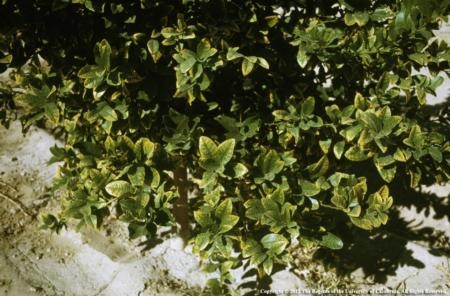
soil salinity irrigation

